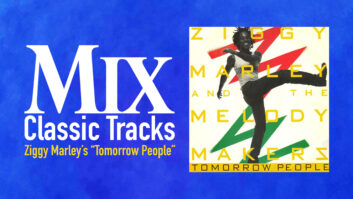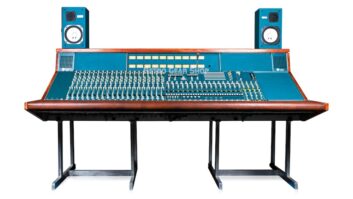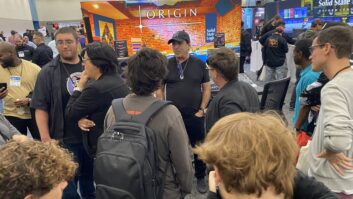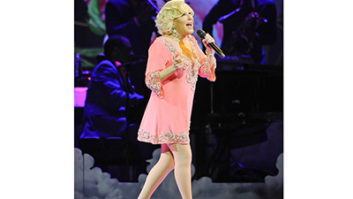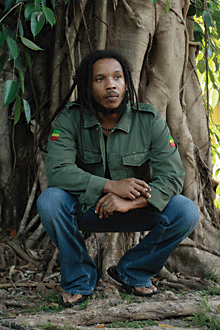
Stephen Marley has been around music his entire life. As the third child of Bob and Rita Marley, born in 1972 (David/“Ziggy” and Cedella are older; there are eight additional half-brothers and -sisters, several of them musical, including Damian/“Junior Gong,” Julian and Ky-Mani), he only got to spend time with his famous father for nine years, but he has been a part of the “family business” practically since he could walk. His first recording came at the ripe old age of 6. If his name is not as well-known as Ziggy Marley’s and Damian Marley’s, it’s because Stephen Marley mostly toiled in the background, singing and playing on and occasionally producing his brothers’ and sisters’ albums — two of them, Damian Marley’s Halfway Tree and Welcome to Jamrock earned Grammys — and for many years he was a member of Ziggy Marley’s group, the Melody Makers. He has also worked a lot outside of the family, doing production work with the likes of The Fugees, Eve, Erykah Badu, Buju Banton and Krayzie Bone (of Bone Thugs-N-Harmony).
So it’s not too surprising that Stephen Marley’s first bona fide solo album, the just-released Mind Control, offers up a compelling mixture of traditional reggae tracks and several modern hip hop numbers, as well as lots of other influences, from flamenco to soul. “I like all different music,” he says in his thick Jamaican accent by phone from his Miami studio, Lion’s Den. “For me, was never only reggae. I love hip hop from the first time I hear it. Music come from the soul, mon — it’s a soul t’ing. People ask me if I do hip hop to be ‘modern.’ No, it doesn’t matter where you are physically in time; it’s where your soul is.”
I ask him how he learned his way around the studio. “I was around the music from my father’s time,” he says. “I was in the studio with him a lot, and as a kid growin’ up, I had relationships with the engineers. Even from then I would go in and power up the board and I learned how to use the group buttons and solo buttons and such forth. But it was about 1990, when there was no engineer around and I wanted to work, I had to step up to the plate and really learn my way around the studio. It come natural to me; I always loved it.”
Stepping into the producer’s chair seemed like a logical choice for Marley because “I work well wit’ people. I play a lot of instruments and I listen to a lot of different kinds of music, so I was prepared for anything. I had my brothers to learn off of. We always talk a lot and we tried different ways of working and doing things. You learn through the years how to get the best out of any person. You get to know the limits, and you learn to work your way around and through different problems that come up.”
Chief among his studio mentors was the legendary engineer Errol Brown, who has been among the top Jamaican studio pros since breaking into the business in the late ’60s. Through the years, Brown has recorded dozens of top reggae artists, including Bob Marley (Survival and Uprising), Burning Spear, Jimmy Cliff, Judy Mowatt, Gregory Isaacs, Israel Vibration and all the recording Marley children. “I’ve known him almost as long as anybody,” Marley notes. “He taught me a lot — he knows the equipment and he knows how to work wit’ musicians.”
On Mind Control, Brown mixed some of the more roots-oriented tunes such as “Inna Di Red” and “Chase Dem,” as well as Marley’s fresh reggae take on the old Ray Charles chestnut “Lonely Avenue.” Marley called on other mixers, too, including James “Bonzai” Caruso, who worked on Damian Marley’s last two albums (as well as the controversial 1999 hip hop/remix album of Bob Marley material, Chant Down Babylon, for which Stephen Marley acted as executive producer) and hip hop savvy Commissioner Gordon, whose credits include Mary J. Blige, LL Cool J, Will Smith and many others, plus tracks on Damian Marley’s Halfway Tree. The album was recorded over a long period at Lion’s Den and Marley Music Studios (formerly known as Tuff Gong Studios) in Kingston, Jamaica. It was mixed at Lion’s Den and Hit Factory/Criteria in Miami. Stephen Marley’s studio is centered around an SSL G Series console and Pro Tools. Engineers on the project included Caruso, Brown, Mark Lee, Greg Morris, Jason Chantrelle, Alrick Thompson and Dave Heuer (with Morris and Lee working on most tracks).
Marley says that “the vibe was right” to make his solo venture now and that he has been amassing songs for it for a number of years. “I wasn’t looking at it as a collection of songs at the beginning,” he says. “I had a song here, a song there, so it was more like each individual song had its own life and its own t’ing. They were written different ways. Sometimes I make a demo with my brothers or whoever, sometimes we just go in and start recording.”
Friends and family make guest appearances throughout the album. The reggae/hip hop “Iron Bars,” which is an angry song about being thrown into jail briefly for weed, includes brother Julian, sister Cedella and rap interludes from Mr. Cheeks and Spragga Benz; “The Traffic Jam,” which has already been a hit in both England and Jamaica, features Damian prominently; Mos Def is on the slow-burnin’ hip hop number “Hey Baby”; Ben Harper lays down a searing slide guitar line on the moody (but still rhythmic) ballad “Inna Di Red”; and Maya Azucena adds a nice female counterpoint to flamenco-influenced “Let Her Dance” while Illestr8 lays down a fast rap. There’s lots of variety in both arrangement styles and sonic textures, which include plenty of interesting electronic vocal treatments, turntable scratches, the occasional string and horn section, and even funky clavinet on “Lonely Avenue.” On different tunes, Marley handles guitars, keyboards, percussion and programming; he’s all over the disc. As for the “children’s chorus” on “Inna Di Red,” it’s three more Marleys: Shacia, Mystic and Summer.
“The hardest part of the whole album,” Marley says, “was knowing when a song was done, ’cause we like to try ideas but sometime it’s too much, you know? But at some point you gotta say, ‘Dat’s it; we done!’ Because you can always put on another part — you wake up in the night with a new guitar part in your head or something. But you have to resist that at a certain point.”
Marley will tour on his own in support of the album, but even this so-called “solo” jaunt will likely have family written all over it. It’s just the way they work: “I know that it was meant for us to be a musical family because it works effortlessly,” he concludes. “We don’t quarrel a lot. We’re very spiritual together and we cherish each other. It’s a very nurturing family and we support each other to the fullest. We don’t take the name Marley lightly, mon.”
